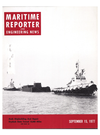
Page 24: of Maritime Reporter Magazine (September 15, 1977)
Read this page in Pdf, Flash or Html5 edition of September 15, 1977 Maritime Reporter Magazine
Perspectives On Third
World Port Development
Within the last decade, con- tainerization has transformed the appearance and operations of many ports in the developed world and has established a dominant position on virtually all deepsea general cargo routes between in- dustrial nations. Despite some significant developments recently on routes to the Caribbean and
Middle East, its impact on the ports and trade of the Third
World generally remains limited.
There are widespread doubts on the applicability of this sophisti- cated, capital-intensive system to the needs and resources of less developed countries, and the spread of containerization into the Third World arena is being fiercely resisted by more conven- tional forms of shipping (and in the Middle East by ro/ro). The most likely challenger on many routes is the modern multipur- pose vessel — combining cost- saving series production with trading flexibility. Western ship- owners and Third World national lines alike are confirming their faith in the future of these mod- ern successors to earlier conven- tional tonnage by ordering them in large numbers. Will multipur- pose ships succeed in halting the spread of container systems to the Third World? Or will the sceptics again be confounded (as they were by the rapid advance of containerization in the West- ern World a few years ago) ?
These and related questions are of great interest to investors, vessel operators and Third World port authorities and governments. "Perspectives on Third World
Port Development," the latest in a long line of studies from HPD
Shipping Publications, examines the factors involved and seeks to provide some answers.
Part I of the study reviews current problems in Third World ports, including congestion which, while it has been most dramatic in OPEC ports, is proving to be more endemic and long-lasting in the ports of the poorer developing countries. Congestion, to which under-investment is a contribut- ing factor, is matched on the other side by the dangers of in- vesting in the wrong sort of port facilities or of committing large amounts of capital too soon—e.g., to specialized container terminals which may remain grossly under- utilized for several years. Either mistake can have near disastrous consequences for a developing country's trade and economic de- velopment. To establish the cor- rect context for decisions on port investment and appropriate ship- ping technologies, the report re- views distinguishing features of
Third World general cargo trade, existing port facilities, capital and labor endowments, inland transport infrastructure, and planning and managerial re- sources. 30 industry with a broad line of pumps for cargo handling, circulating, ballasting, drydock dewatering, main feed, and engine room auxiliaries.
Moving more fluids forthe
In Part II, the report goes on to compare the two main con- tenders for the deepsea general cargo traffic of developing coun- tries—modern multipurpose ship- ping and fully cellular systems.
Semi-containerships (an interme- diate lift-on/lift-off shipping mode) are also examined. The significant features of each sys- tem are analyzed, including ves- sel characteristics and costs, com- patibility with Third World trade flows, and drafts compared with depths of water in Third World ports. Port terminal requirements and costs are contrasted. One finding is that the level of con- tainerizable traffic required to justify individual cellular serv- ices is considerably below that justifying investment in a spe- cialized container terminal. The potential contribution of multi- purpose berths, and other ways of bridging this gap—common in
Third World ports—are assessed.
The report identifies the current stage of container terminal de- velopment in developing countries and reviews plans for further specialized facilities. Another finding is the importance of effi-

 23
23

 25
25
